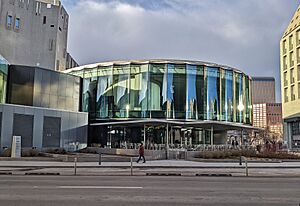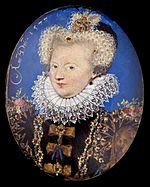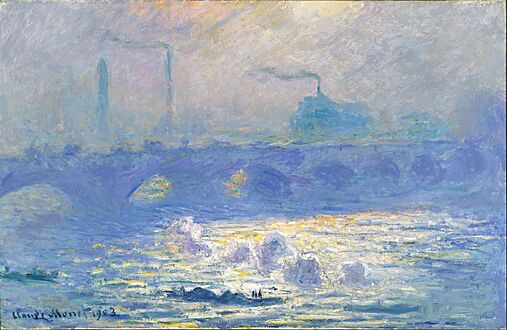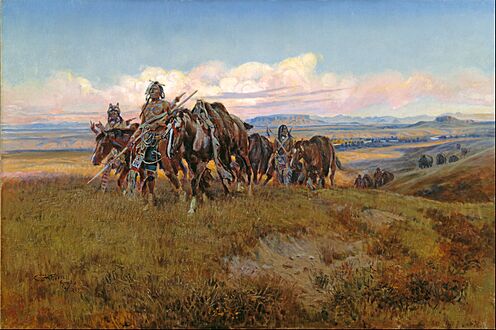Denver Art Museum facts for kids
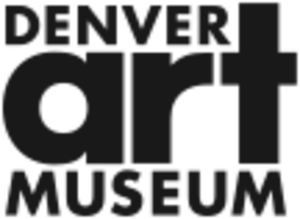 |
|
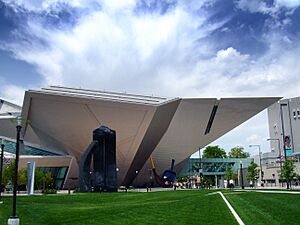
Frederic C. Hamilton building at DAM
|
|
| Location | 100 W 14th Avenue Pkwy Denver, Colorado |
|---|---|
| Type | Art museum |
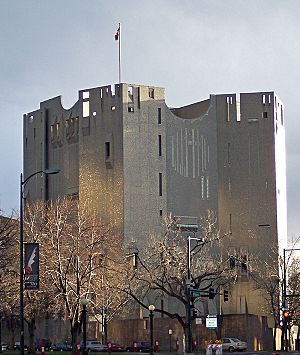
The Denver Art Museum (DAM) is a big art museum in Denver, Colorado. It has a huge collection of over 70,000 artworks from all over the world and from different times. It is one of the largest art museums between the West Coast and Chicago. The museum is especially famous for its American Indian art collection. It also has a special part called The Petrie Institute of Western American Art, which looks after art from the American West.
The museum's Martin Building was designed by a famous Italian architect named Gio Ponti in 1971. In 2018, the museum started a big renovation project. This project cost $150 million and helped connect the museum buildings better. It also made Ponti's original building even better. The renovation added new spaces for art, two new places to eat, and a new welcome center.
Contents
- History of the Museum
- Art Collections
- Selected Collection Highlights
- Learning and Fun
- Funding the Museum
- Media Mentions
- See also
History of the Museum
Early Years (1893–1923)
The Denver Art Museum started as the Denver Artists Club in 1893. In 1917, the club changed its name to the Denver Art Association. Two years later, it opened its first art galleries. In 1922, the museum opened more galleries in a building called Chappell House. This house was given to the museum by Mrs. George Cranmer and Delos Chappell. In 1923, the Denver Art Association officially became the Denver Art Museum (DAM).
Growing the Museum (1948–1974)
In 1948, the DAM bought a building near Civic Center Park. This building was updated and opened as the Schleier Memorial Gallery in 1949. The museum needed even more space for its growing art collection. The Kress Foundation offered to donate three valuable art collections. But the museum needed a new building to keep them safe.
Even though voters did not approve funding in 1952, the museum kept raising money. They opened a new building, the South Wing, in 1954. This new space allowed the DAM to receive the three Kress Foundation collections.
The North Building, a large seven-story addition, opened in 1971. It was designed by the Italian modernist architect Gio Ponti. This building is his only completed design in the United States. Ponti wanted the DAM building to be different from other museums. It looks like a "castle" with 24 sides. Over one million shiny glass tiles cover the outside of the building.
New Additions (2006–Present)
In 2006, the Duncan Pavilion and the Frederic C. Hamilton Building were added to the museum. The Duncan Pavilion was a new area that connected the older buildings to the Hamilton Building. It was designed to be fun for kids and families. It was also used for events like weddings.
In 2016, the Denver Art Museum announced a big $150 million project. This project aimed to connect the museum's buildings better. It also updated Ponti's building, which is now called the Martin Building. The renovation added new art galleries and places to eat. It also created the new Sie Welcome Center. This project was finished in 2021, just in time for the 50th anniversary of Ponti's building. The Duncan Pavilion was taken down in 2019 to make way for the Sie Welcome Center.
Hamilton Building
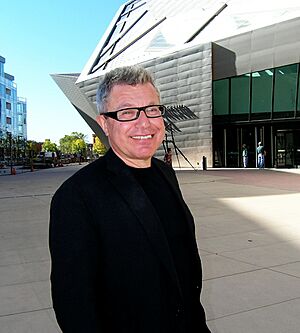
The Frederic C. Hamilton Building holds the museum's Modern and Contemporary Art. It also has African Art, Oceanic Art, and some Western American art. This building was designed by Studio Daniel Libeskind and Davis Partnership Architects. It opened on October 7, 2006. The building is covered in glass and titanium. It was the first building by Libeskind to be finished in the United States.
The Hamilton Building is known for its bold and unique design. It has sharp angles and sticks out in many directions. It is supported by a huge steel structure. None of its 20 sides are parallel or straight. The building's design looks like the sharp angles of the nearby Rocky Mountains. It also looks like the geometric crystals found near Denver. Architect Daniel Libeskind said he was inspired by the mountains and the people of Denver.
The Hamilton Building is the main entrance to the museum. This project made the museum twice as big. This allowed for many more artworks to be shown.
Martin Building
On January 10, 2018, the Denver Art Museum started a big renovation of its North Building. This building was the only one in North America designed by Gio Ponti. It was one of the first tall art museums. In 2019, the North Building was renamed the Martin Building. This was to honor Lanny and Sharon Martin, who gave a large gift of $25 million for the renovation. The city of Denver also helped with $35.5 million in funding.
The renovation updated all seven floors of galleries. It also created new learning spaces. A new restaurant, a café, and the Sie Welcome Center were also added. The design included new skylights to show off Ponti's original ideas. The outside of the building also got new lighting and updated glass tiles. The project was finished in 2021, for the building's 50th anniversary.
When Ponti's building was first made in 1971, it was designed for 100,000 visitors a year. By 2017, the museum had about 850,000 visitors each year. To handle more people, the renovation added over 72,000 square feet of new and updated spaces. It also made important safety and building improvements.
Sie Welcome Center
The new Sie Welcome Center was built as part of the museum's big renovation. It creates a new, easy entrance to the Martin Building. It also connects to the Hamilton Building. It is named after Anna and John J. Sie, who gave $12 million to the project. This round, glass building is the new main entrance and ticket area for the Martin Building.
The Sie Welcome Center is home to The Ponti, a restaurant that uses local ingredients. There is also a more casual café for lighter meals. On the second floor is the Sturm Grand Pavilion. This is a large event space with curved glass panels. It offers great views of the city.
Bonfils-Stanton Foundation Galleries
As part of the Martin Building renovation, new Bonfils-Stanton Foundation Galleries were created. These galleries add 7,000 square feet of new space for the museum's permanent collection. This area was once used for storing art. Now, it is a completely new space for temporary exhibitions. These shows feature art from the museum's huge global collections.
New Design Galleries
During the Martin Building renovation, the original Bonfils-Stanton Gallery was changed. It was split horizontally to create 10,000 square feet of new gallery space on the second floor. These new spaces include the Joanne Posner-Mayer Mezzanine Gallery, the Amanda J. Precourt Design Galleries, and the Ellen Bruss Design Studio. The museum worked with a design firm called OMA to create the inside of these new exhibition spaces.
Duncan Pavilion
The Duncan Pavilion was an addition to the Bach Wing of the Denver Art Museum. It opened in February 2006. The pavilion was taken down in 2017. The Sie Welcome Center is now in its place. The Duncan Pavilion used to connect the Hamilton Building to the 1971 Gio Ponti-designed North Building. It helped preserve the older Bach Wing and improved its systems.
Art Collections
The Denver Art Museum has many different art collections. These include:
- African Art
- Architecture and Design
- Art of the Ancient Americas
- Asian Art
- Modern and Contemporary Art
- Native Arts (African, American Indian, and Oceanic)
- New World (pre-Columbian and Spanish Colonial)
- Painting and Sculpture (European and American)
- Photography
- Western Art
- Textile Art and Fashion
African Art
The museum has about 1,000 pieces of African art. Most of these are from the 1800s and 1900s. The collection includes sculptures, textiles, jewelry, paintings, and drawings. Many pieces are from west Africa. They are made from wood, metals, fibers, clay, and other materials.
Art of the Ancient Americas
This collection covers over four thousand years of art. It includes historical works from people and communities in Mesoamerica, Central and South America, the Caribbean, and the Southwestern United States. This department started in 1968. It is known for its collection of Central American ceramics, jade, and stone sculptures.
Architecture and Design
The Architecture, Design and Graphics department started in 1990. The collection focuses on Italian design from the 1960s and 1970s. It also has American graphic design from the 1950s to today. Other areas include furniture and product design from after World War II in America and Western Europe. It also features modern Western European and Japanese design.
Asian Art
The museum's Asian art collection has galleries for art from India, China, Japan, and Southwestern Asia. It also includes works from Tibet, Nepal, and Southeast Asia. The collection started in 1915 with a gift of Chinese and Japanese art. It covers art from the fourth millennium B.C. to the present day.
European and American Art Before 1900
The Denver Art Museum started getting important European art in the 1930s. Horace Havemyer donated works by artists like Corot, Courbet, and Millet. From 1932, money from the Helen Dill Bequest helped the museum buy paintings by Claude Monet, Camille Pissarro, Alfred Sisley, and Pierre-Auguste Renoir. It also bought works by American artists like Thomas Hart Benton, Winslow Homer, and William Merritt Chase.
Famous artists in this collection include Claude Monet (Waterlilies), Camille Pissarro (Autumn, Poplars, Éragny), Winslow Homer (Two Figures by the Sea), and Edgar Degas (Examen de Danse).
The Berger Collection
The Berger Collection is a large private collection of mostly British art. It has about 200 works and covers over six centuries. It is strong in Renaissance portraits, including works by Hans Holbein the Younger. Other artists include Nicholas Hilliard, Thomas Gainsborough, and David Hockney.
The Hamilton Collection
Frederic C. Hamilton gave 22 Impressionist artworks from his private collection to the museum in 2014. This included Vincent van Gogh's Edge of a Wheat Field With Poppies. There were also four works by Claude Monet, three by Eugène Boudin, and pieces by Paul Cézanne, Edouard Manet, and Auguste Renoir.
Indigenous Arts of North America
This collection includes works by many modern artists. Some of these artists are Jeffrey Gibson, Kent Monkman, Rose B. Simpson, Fritz Scholder, T.C. Cannon, and Jaune Quick-to-See Smith. The collection also features works by James Luna, Marie Watt, Nicholas Galanin, and Virgil Ortiz.
Latin American Art
The Denver Art Museum has the largest collection of Latin American art in the United States. This art was made between the 1600s and 1800s. It has over 6,000 objects. These works come from Mexico, Central and South America, the Caribbean, and the Southwestern United States. The collection includes paintings from the Spanish Colonial Period.
Modern and Contemporary Art
The museum's Modern and Contemporary art collection has works by famous artists. These include Pablo Picasso, Marcel Duchamp, Henri Matisse, and Georgia O'Keeffe. It also has 33 paintings, drawings, and collages by Robert Motherwell. The collection shows important art movements from after World War II. These include abstract expressionism, minimalism, and pop art.
Herbert Bayer Collection and Archive
The Herbert Bayer Collection and Archive has over 8,000 artworks. It also has many documents. This collection is dedicated to the artist Herbert Bayer, who lived in Colorado for 28 years. Scholars from all over the world visit to study this collection.
Linda
Linda, by Denver artist John DeAndrea, is a very popular sculpture. It is a life-size, realistic sculpture of a sleeping woman. It is made of polyvinyl. The piece is sensitive to sunlight, so it is only shown for short times. It looks so real that people often think it is breathing.
The Shootout
In 1983, the museum became home to the pop-art sculpture The Shootout by Red Grooms. It shows a cowboy and an Indian shooting at each other. The sculpture was moved to the roof of the museum restaurant. It had been moved from other places in Denver because some people protested it. The sculpture was removed from view in November 2017. The Sie Welcome Center now stands where it used to be.
AS TO BE IN PLAIN SIGHT
This piece is one of the most photographed artworks in the museum. It is an aluminum cutout of the words "AS TO BE IN PLAIN SIGHT." It was made by contemporary artist Lawrence Weiner. The piece is on a wall on the museum's third floor. It is hard to see from most parts of the museum, which makes it ironically hidden in plain sight. It was first outside the museum but moved inside in 2009.
Oceanic Art
The Oceanic art collection has about 1,000 objects. It focuses on 20th-century New Guinea art and 19th-century Polynesian art. These collections include sculptures, bark cloth, wood carvings, and some works by modern artists.
Photography
The DAM created a special department for photography in 2008. The collection has many 19th-century photos, especially of the American West. It also has European and American modernist photography. Works by early Western photographers like William Bell and Timothy O'Sullivan are included.
Textile and Fashion
The Textile Art and Fashion department has over 5,000 pieces. These come from Asia, Europe, and North and South America. The collection includes ancient textiles and modern art and fashion from the 1700s to today.
Western American Art
This part of the museum focuses on art about the American West. It includes art about its people, history, and landscapes. Important works include In the Enemy's Country by Charles M. Russell and The Cheyenne by Frederic Remington. Other highlights are Thomas Moran's Mount of the Holy Cross and Albert Bierstadt's Wind River Country.
The Harmsen Collection
In 2001, the Western American Art collection grew with a gift of over 700 art objects from the Bill and Dorothy Harmsen Family. This gift helped start the institute of Western American art at the DAM. In 2007, it became the Petrie Institute of Western American Art after a gift from the Thomas A. Petrie family.
The Roath Collection
In 2013, the museum received a gift of American art from Henry Roath. This gift greatly increased the importance of its Western collection. The Roath Collection has over 50 works. These works were made between 1877 and 1972. Artists include Albert Bierstadt, Thomas Moran, Frederic Remington, and Ernest L. Blumenschein.
Selected Collection Highlights
Learning and Fun
The museum's Learning & Engagement department focuses on making museum visits fun and successful. They create things like audio tours, videos, and hands-on art areas. They also have interactive learning for young people, both in school groups and with families.
Family-friendly programs include the Just for Fun Family Center, gallery games, and Family Backpacks. The museum also has special programs for visitors with Alzheimer's or dementia, and Low Sensory Mornings.
A main goal of the museum's renovation was to put its educational programs at the center of the campus. The new Bartlit Learning and Engagement Center has over 12,000 square feet of flexible space. It has workshop rooms and the Singer Pollack Family Wonderscape. This area will show student-created exhibitions and host school events. The Bartlit Center also has the Morgridge Creative Hub, which is over 5,600 square feet.
Funding the Museum
The Denver Art Museum is run by a non-profit group, separate from the City of Denver. A lot of its money comes from a small sales tax. This tax is collected in the Scientific and Cultural Facilities District (SCFD). This district includes seven counties around Denver. The tax helps fund about 300 arts, cultural, and science groups.
About 65% of this tax money goes to the Denver Art Museum and four other big cultural places in Denver. These are the Denver Botanic Gardens, the Denver Zoo, the Denver Museum of Nature and Science, and the Denver Center for the Performing Arts. The museum also gets large private donations and loans of art. In recent years, the Denver Art Museum has had over 600,000 visitors each year.
Media Mentions
The museum was shown in the Aerial America "Colorado" episode on Smithsonian Channel in 2012. It was also mentioned in a How Do they Build That? episode in 2022. In January 2024, employees of the Denver Art Museum announced they wanted to form a union. The museum's director did not agree to recognize the union at that time.
See also
 In Spanish: Museo de Arte de Denver para niños
In Spanish: Museo de Arte de Denver para niños


